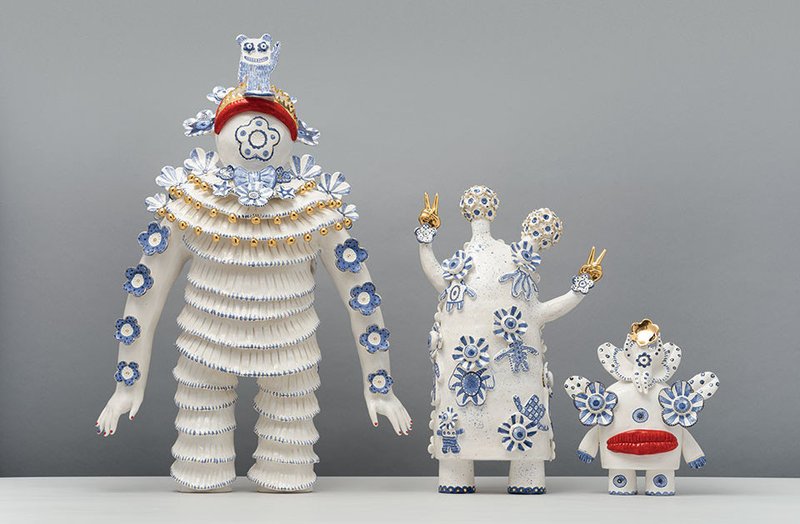Let’s ensure government policy is informed by artists’ perspectives
This month, a lot of our attention has been on responding to inquiries and consultations which have impact on the lives and livelihoods of artists, arts workers and organisations.
This month, a lot of our attention has been on responding to inquiries and consultations which have impact on the lives and livelihoods of artists, arts workers and organisations.

Vipoo Srivilasa (L-R) True Friendship Is Rare, 2022, glazed ceramic with gold lustre and enamel paint, 59 × 32 × 12 cm; Friends Are Flowers In The Garden Of Life, 2022, glazed ceramic with gold lustre, 40 × 21 × 12 cm; You Don't Have To Be Crazy To Be My Friend. I'll Train You., 2022, glazed ceramic with gold lustre and enamel paint, 22 × 18 × 8 cm, all from the exhibition, Always Better Together, Olsen Gallery Sydney 2022. Photo by Simon Strong.
Due this week is the Copyright Enforcement Review and Inquiry into National Cultural Policy, next week is the new deadline for the Inquiry into Workforce Australia Employment Services. NAVA encourages you to add your voice to help ensure that government policy is informed by artists' perspectives.
Due 5pm Tuesday 7 March 2023
Copyright protects certain types of works from being copied or used in particular ways without the copyright owner’s permission. The Copyright Act 1968 (Cth) gives creators control over their work (e.g. how it is used, distributed or reproduced) and allows creators to charge money for their work. In practice, many artists feel exploited and helpless when they discover their work has been reproduced without their permission.
The Attorney General’s Department is undertaking a review to understand where the current system is failing artists and determine recommendations for improved enforcement mechanisms.
NAVA’s submission supports the recommendation made by Arts Law Centre of Australia for a forum to hear small intellectual property claims, similar to the styles of the US Copyright Claims Board (CCB) and the UK Intellectual Property Enterprise Court (IPEC). NAVA also supports the Australian Copyright Council submission outlining international examples of tribunals and alternative dispute resolution procedures from which Australia can learn.
NAVA recognises that copyright infringement of visual artists’ work is increasing and highlights the following:
Due Thursday 9 March 2023
Following the release of the Australian Government’s Revive: a place for every story, a story for every place, Greens Senator Sarah Hanson-Young called for an inquiry into the new national cultural policy saying:
After a decade of neglect, a national cultural policy was very welcome. But we must make sure the policy is as strong as it can be, with adequate funding behind it. A Senate inquiry will provide an opportunity to examine the policy in detail ahead of the May budget.
The focus of NAVA’s response is to first recognise the positive impact of the launch of the policy on the arts sector and assert the need for bipartisan support for this, or any policy or plan to ensure the stability of the industry.
There is much to celebrate in this policy and a lot of that has to do with the sentiment of it. The work now is to unpack and develop the details of the initiatives and actions, ensuring they reach across the visual arts sector. All of this will take time.
As well as continued work on advocating for a legislated Award for the visual arts as part of the upcoming Review of Modern Awards, NAVA will be engaging the sector to collaborate on visual arts, craft and design specific recommendations for policy actions including:
In the meantime, this inquiry looking at detail and funding is a useful opportunity to highlight our initial thinking on the above list as well as address concern about the invisibility of the visual arts, craft and design throughout the policy and the questions being raised across our sector:
Deadline extended to 17 March 2023
Late last year, Julian Hill MP, Chair of the Select Committee on Workforce Australia Employment Services, invited honest, direct and bold submissions, saying:
This inquiry is a comprehensive, first-principles review of Workforce Australia hence nothing is off the table. We are actively questioning all assumptions about the design and implementation of employment services in Australia, as well as a range of other issues related to jobseekers’ and employers’ interactions with employment services. Fundamental aspects of the system require re-examination.
NAVA's submission notes that many find it near impossible to lodge the work they’ve been seeking as artists to comply with the requirements under the current points system. Frustratingly, Centrelink continues to divert artists into doing work that has no or little relevance to their career intentions rather than trying to help them to sustain careers as professional visual arts, craft and design practitioners. This means that visual artists and independent arts workers are having to do twice the amount of work - building their professional practice and seeking paid opportunities in the arts, as well as submitting job applications in unrelated fields and participating in other recognised programs to satisfy Centrelink and secure income support when they need it.
While NAVA strongly opposes mutual obligation systems, we recognise that changes to what is recognised as employment seeking activity will have huge impact for artists and arts workers. Professional visual arts and craft practitioners are likely to actively seek ‘employment-like’ opportunities in a number of different forms and from a wide variety of sources. This includes applying for and undertaking residencies; applying for grants and funding; meeting with curators, galleries and potential buyers; sitting on boards; voluntary work at a gallery, including artist-run initiatives (ARIs); attending industry events, presenting talks and making connections; participating in art, craft and design fairs; collaborating and facilitating artwork; making artwork for sale, exhibition, or to enter into prizes; making artwork for fundraisers; undertaking research, training or mentorship; building and maintaining a website and other marketing activities.